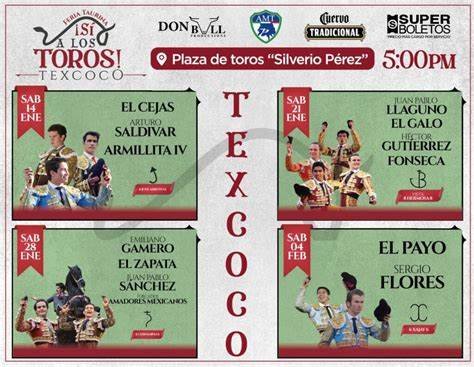Chances to see some of Mexico’s most talented matadors
Beginning last Saturday, the four corridas comprising Don Bull Productions’ 2023 feria taurina at Texcoco, which feature some of the country’s most interesting toreros, are being streamed free of charge on Mexico’s tauronet.tv channel.
The Vistahermosa corrida this coming Saturday (January 21) includes two of Mexico’s newest matadors - Héctor Gutiérrez and Isaac Fonseca - both of whom created a stir in Spain when they appeared there as novilleros.
Héctor Gutiérrez (image from torosyfaenas.com.mx)
Héctor Gutiérrez was born in Aguascalientes in 2000, learned toreo at la Escuela de Espectáculos Taurinos de México and debuted sin picadores at Málaga, Spain, at the age of 14. By 2017, he was appearing with picadors, and his strong season in Spain in 2019 marked him out as someone worth watching. He took the alternativa from Emilio de Justo at Guadalajara, Mexico, on November 28 2021 (a day of mixed fortunes as he cut two ears but was also injured), and since then has focused on establishing a career in his home country. Héctor took part in 23 festejos in 2022, winning 30 ears and one tail, and had a bull of Jaral de Peñas indultado at Guadalajara last October.
Isaac Fonseca
Isaac Fonseca is probably more well-known to European aficionados currently, as, spectacularly brave, he had two strong seasons as a novillero in France and Spain in 2021 and ‘22. He is older than Gutiérrez, having been born in 1998, but comes after him as his alternativa occurred just last August at Dax. Isaac first appeared in public with bulls in his home town of Morelia just before his 12th birthday and debuted without picadors in 2016. He debuted in Madrid’s Las Ventas two years later before moving up to appear with picadors at Gijón in August 2019. Now based in Spain, he fought in 11 further novilladas that year and in 21 festejos in 2021, when novilladas resumed after the pandemic, finishing second in the escalafón. He won Villaseca de la Sagra’s ‘Alfarero de Oro’ and was adjudged triunfador of the final of la Liga Nacional de Novilladas, appearing alongside Manuel Perera, Manuel Diosleguarde and Jorge Martínez. 2022 brought triumphs as a novillero in Valencia, Sevilla, Madrid and Pamplona, and as a matador at Nîmes, Morelia (where he secured an indulto), and last month at Caxuxí and Apizaco. Unlike Gutiérrez, who will probably remain on the other side of the Atlantic, Fonseca is planning on a full European temporada as a matador de toros this year, including a confirmación de alternativa in Madrid.
The other noteworthy Texcoco corrida is the February 4 mano a mano featuring Sergio Flores and Octavio García El Payo and bulls of Xajay.
Sergio Flores
Born in Apizaco in 1991, Sergio Flores took the alternativa from El Juli in Bayonne in September 2012 after a handful of appearances as a novillero con picadores in 2009 and ‘10 and one full season in France and Spain in 2011, when he finished fifth in the escalafón. Although he cut two ears on the afternoon of his alternativa, the bulk of his 2012 temporada in Europe was unsuccessful and, since then, he has appeared intermittently on this side of the Atlantic, with single numbers of corridas in 2013, 2018, 2019, 2021 and ‘22, this last season involving a sole corrida at Orthez last July, when he gave the alternativa to Francisco Montero. In Mexico, 2017 was a particularly fruitful season for Sergio, who earned 15 salidas a hombros, two of these in Mexico City’s Monumental Plaza. In 15 corridas in Mexico’s principal plaza, he has left through its puerta grande seven times. While he is generally inconsistent, Flores has garnered a reputation as one of Mexico’s most artistic matadors when he is on song.
El Payo
El Payo is another Mexican torero well worth watching. Born in Querétaro in 1989, Octavo García finished fifth in the escalafón de novilleros for Spain and France in 2008 (the year of his October alternativa at the hands of Morante de la Puebla in Pachuca), but has rarely been seen in Europe subsequently. He did confirm his alternativa the following year during San Isidro, also performing at a handful of other Spanish plazas, but has pretty much confined his appearances to Mexico ever since. An exception was 2016, when he fought in nine corridas in Spain, going out the main gate on six occasions, but since then he has remained in his home country.
I was very impressed when I saw him at Tlaxcala in 2015, finding him to be a serious, classical torero, and the former editor of 6Toros6, José Carlos Arévalo, has recently written of him: “Some years ago, I can’t remember where, I saw a young espada called El Payo torear […] He displayed class and elegance, with innate temple and a natural approach. He wasn’t well-known at this time, but I reckoned his toreo was that of a figura. I never saw him again; it seemed he didn’t interest anyone in Spain. Sometime later, I heard he’d received a huge goring in Mexico, one of those that causes toreros to give up. I felt that distant cornada as a loss. A long time after that, I was shown a video of a mano a mano with Morante in San Luis Potosí and El Payo performed like an established figura del toreo. For me, his triumph felt like a resurrection.”
The transmission of these Texcoco corridas gives the European aficionado an opportunity to see these talented toreros in action - toreros who, apart from Fonseca, are unlikely to be seen in Spain or France in the near future. Each live showing begins at 11pm in the UK and is also available after the event on tauronet.tv’s ‘Repeticiones’ page.




